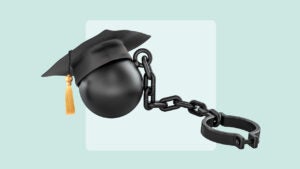With student loan relief extended to Aug. 31, 2022, here’s what you can do with the extra money

As the coronavirus pandemic enters its third year, many consumers are still dealing with the toll COVID-19 has taken on their finances. But the good news for those struggling with student loan debt just got a bit better: The federal government has once again extended its pause on student loan repayments for four months — until Aug. 31, 2022.
Repayments were due to resume after May 1.
The pause, part of the Biden administration’s relief aid efforts, temporarily eases the financial burdens for some 42 million borrowers holding federal student loans, giving them a bit more time to get their finances back on track or to further improve their financial positions before payments restart again
Student loan repayment pause extension: What to do next
1. Still struggling to get by? You may be better off focusing your spending on the essentials and staying out of further debt
Paying every bill can be a struggle during tough times. Consider focusing your available money on essential items such as food and housing while you’re trying to stay afloat.
Budgeting is a great way to understand where your money is going and discover savings opportunities.
Regarding your student loans, before the pandemic you might not have considered an income-driven repayment plan. Or you might not have been eligible. So applying well before Aug. 31, 2022 could be a smart move.
Deferment or forbearance are other potential options.
2. Bouncing back nicely after tough times? It may make sense to start saving so you’re in a good position once payments resume
Student loan monthly payments are typically $200-$300, according to a Federal Reserve survey conducted in late 2018, meaning most borrowers who would otherwise be paying back their loans could have an extra $800-$1,200 available to them during the next four months.
Use this money to build up your savings if you’ve managed to avoid costly high-interest debt during the pandemic. That savings account could be an emergency fund. Or some of the money could help you with future student loan payments in 2022. Make sure you choose a high-yield savings account to maximize the interest you’ll earn.
“You can use that extra cash flow for other purposes as well: boosting an emergency fund, boosting retirement savings, paying down other high-interest rate debt — like credit card debt,” says Greg McBride, CFA, Bankrate chief financial analyst. “All of those would be positive financial steps.”
McBride says saving six months of expenses in an emergency fund is an adequate cushion.
“But that’s a destination, not a starting point,” according to McBride. “The reality of it is, what constitutes six months of expenses is itself a moving target for many years.”
The pause on student loan payments buys you some time to rebuild your emergency savings if it was drained during a period of income disruption earlier on in the pandemic, McBride says.
3. Income never took a hit? Consider boosting your emergency fund, or even your investments (if your emergency fund is already in a good place)
Some have been fortunate enough to redirect their paused monthly student loan payments into savings during the pandemic. The next four months provide one more chance to add these funds to an emergency fund, if you have one.
You might also consider investing some of this extra money. Just make sure you have an adequate balance in your emergency fund first.
Increasing your 401(k) contributions — if you have one through your employer — or moving money into an IRA may make sense for your situation.
The window to make IRA contributions remains open until Tax Day in mid-April 2022, McBride says. Or you could also choose to get ahead on your federal student loan balance.
“With no interest being charged, you can still make payments on your student loans and every dollar goes directly towards paying down the loan balance,” he says. “There’s no headwind from interest. So there is the ability to accelerate debt repayment if you’re at the luxury of doing so.”
Bottom line
Not having to make student loan payments through the end of the year could help you stay afloat or further improve your financial status. Reevaluate your budget and plan ahead so that you’re prepared when federal student loan payments restart later in 2022.






